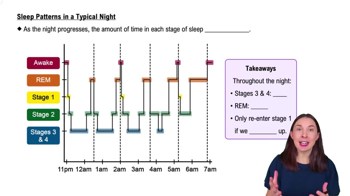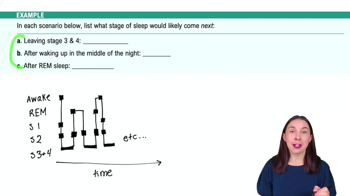Table of contents
- 1. Introduction to Psychology1h 43m
- 2. Psychology Research2h 20m
- 3. Biological Psychology2h 41m
- 4. Sensation and Perception28m
- 5. Consciousness and Sleep32m
- 6. Learning41m
- 7. Memory34m
- 8. Cognition37m
- 9. Emotion and Motivation35m
- 10. Developmental Psychology33m
- 11. Personality48m
- 12. Social Psychology41m
- 13. Stress and Health41m
- 14. Psychological Disorders44m
- 15. Treatment47m
5. Consciousness and Sleep
Sleep
Struggling with Psychology?
Join thousands of students who trust us to help them ace their exams!Watch the first videoMultiple Choice
In studies in which volunteers spend several days without access to information about day or night, their sleep–wake cycles
A
became nonexistent.
B
shortened.
C
stayed exactly the same.
D
lengthened.
 Verified step by step guidance
Verified step by step guidance1
Understand the concept of circadian rhythms, which are physical, mental, and behavioral changes that follow a 24-hour cycle, responding primarily to light and darkness in an organism's environment.
Recognize that the absence of external cues like light and darkness can disrupt these circadian rhythms, leading to changes in sleep-wake cycles.
Consider the role of the suprachiasmatic nucleus (SCN) in the brain, which acts as a master clock, regulating circadian rhythms based on light information received through the eyes.
Acknowledge that in the absence of light cues, the body's internal clock may default to its natural cycle, which is slightly longer than 24 hours, leading to a lengthening of the sleep-wake cycle.
Conclude that without external cues, the sleep-wake cycle tends to lengthen, as the body's internal clock operates on its intrinsic rhythm, which is typically longer than the 24-hour day.

 3:25m
3:25mWatch next
Master Circadian Rhythms with a bite sized video explanation from Hannah Gordils
Start learningRelated Videos
Related Practice


































































































![Race, Genes and IQ Differences | Bret Weinstein [Mini Clip]](https://img.youtube.com/vi/IztL_m3pd70/mqdefault.jpg)



































































































